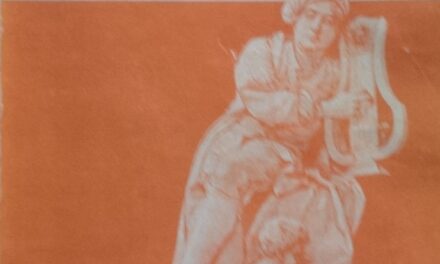Unlike Johann Sebastian Bach’s cantatas and masses, his settings of the Biblical accounts of the crucifixion of Jesus are more contextually-dependent. When removed from their normal time and place (the Christian Holy Week, normally Good Friday, within a liturgical worship context), they lack a dimension which has little to do with music but much to do with their emotional impact. To hear the St. Matthew Passion in June in a concert is a different experience, one in which the listener is more likely to hear it as a musical event.
Bach composed the St. Matthew Passion in 1727 for Leipzig’s Thomaskirche, where he repeated it at least two more times. It is, in length, his most monumental work; my Bach Gesellschaft full score comprises 289 pages! It calls for both choral and instrumental forces to be divided into two groups, which he would have placed on either side of the rear gallery at the St. Thomas’ Church, the organ and harpsichord being between them along with their respective bass instruments. Performing from the front of Chapel Hill’s University United Methodist Church, such separation was not possible; nevertheless, the different groups were easily differentiated by the audience (which was far smaller than this performance deserved). Conductor Scott Allen Jarrett moved about, depending on the requirements of the score, to better provide lines-of-sight between audience and performers.
This concert, repeated in Charlotte the following evening, was the closing event of an excellently-planned Bach Festival which included several Michaelmas cantatas and solo recitals for organ and for violin. The chorus of 27 voices (plus 11 young women of the Charlotte Latin School) and some 35 members of the orchestra (divided into the two groups required by this score) performed at a consistently high level of musicianship. Tenor Steven Soph in the role of the Evangelist and Jason Steigerwalt in the role of Jesus were exemplary in their portrayals, as were the many soloists from the chorus and from the orchestra, each of whom deserves praise.
While the number of singers approximated the maximum that Bach used, the number of string players was greater than Bach used, which led to some balance problems between vocal soloists and orchestra. Using girls’ voices for the ripieno chorale parts in the chorale fantasia movements worked well when the pitches rose to C5 or above; within the staff, however, much was lost within the thick texture.
The chorus in a traditional Passion setting plays two primary roles: part of the drama (i.e., “crowd scenes”), and as part of the worshiping congregation (the chorales or hymns). Especially in Part I of this performance, the chorales were sung at a very fast tempo, regardless of their texts. Often, these texts serve as congregational reflections on the unfolding drama; Bach personally selected them for that reason. When sung quickly, they may be beautiful in sound, but lacking in the interpretive/reflective dimension. In several non-chorale movements, some instrumentalists struggled to meet Jarrett’s tempos. Nevertheless, it must be recognized that his knowledge of this score is total. He knows every note, knows how he wants it to sound and, despite eschewing a baton, is totally clear in his conducting.
The tempo pendulum for this (and most other) Bach works has swung far over the past six decades. Otto Klemperer’s recording of the St. Matthew, using huge performing forces, runs over 4 hours; Herbert von Karajan’s clocks in at a little over 3 hours and 42 minutes. Things began to change with the rediscovery of Baroque performance practices, spearheaded by British harpsichordist and musicologist Thurston Dart. More recent recordings include Nicholas Harnoncourt’s, at 2 hours 42 minutes, and John Eliot Gardiner’s, at a brisk close-to 2 hours 30 minutes. As is so often the case, the truth (i.e., the tempos that Bach himself would have used) is likely somewhere between those disparate ends. (Tonight’s performance was roughly 2 hours 40 minutes.) The clues are in the music itself: the two great chorale fantasias which open and close Part I. In each, the chorale melody appears with little ornamentation in the soprano part, doubled by organ. Because of the surrounding textures, the chorale tunes can’t be sung too fast. Applying similar tempos to the rest of the work’s chorales will likely bring us closer to the composer’s practices.
To acknowledge the contributions of each vocal and instrumental soloist would exceed the space required to do each one of them justice, but high praise to organist Nicolas Haigh, who played every note of the keyboard continuo score, the glue which holds the entire work together. (Had space permitted, the addition of a harpsichord for the multitudinous recitatives would have provided an additional tonal contribution to the ensemble.) Questions of tempo aside, this was a definitive performance. The German diction was uniformly excellent, with only a few words which needed adjustment (e.g., betet / betete and schwer). The “crowd scenes” were exciting, capturing the action perfectly. The antiphonal interplay between chorus/orchestras I and II was beautifully delineated.
This is only the second year of the Bach Akademie Charlotte; they already have staked a claim to be the state’s finest representative of JSB’s greatness.











